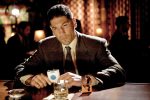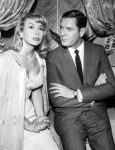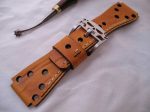IWC Schaffhausen
Strap Culture: The Original Watch Guys
We now know that lunch in any decent London restaurant or business class lounge will provide a parade of well-adorned wrists. We’re used to counting TAG Heuers and IWCs at sporting events, Big Bangs in bars. We know about various cults such as collectors who swoon for tropical dials, while entrepreneurial enthusiasts such as George Bamford have addressed the need for individualism with blackening the cases of Rolexes. It’s the modern world. But I was stunned to read about the cult for after-market straps that was prevalent among Los Angeles policemen in the 1950s.
Fascinated as I am by what you might call “the film noir era” of the 1940s and 1950s, I never investigated it in terms of horological interests. I loved both the true history of the times and the on-screen interpretation. Movies and books with their roots in Jim Thompson and Cornell Woolrich, Chandler and Hammett and Cain, brought to life by Lloyd Nolan and Mike Mazurki and Elisha Cook Jr. Thus, I was a sucker for a recent, short-lived TV series called Mob City.
Understandably, films and TV shows made during that era didn’t have to reconstruct a thing: you wanted a contemporary wardrobe for the cast, you simply went to the nearest clothing store. Same for the watches. But if you make a film today about the 1950s, and you don’t want to ruin it for the watch geeks (as they did Hollywoodland by fitting a character from 1958 with a 2005 Chopard), then you need researchers. And a willingness to demand authenticity. Mob City and L.A. Confidential nailed it.
Anyway, there I was, reading Buntin’s real-life tale of bent cops in post-WWII Los Angeles, when I came across this on page 186, quoting legendary newspaper woman and editor Agnes Underwood’s take on the attitudes of the cops who peopled Mob City, L.A. Confidential and the real Los Angeles of the period. Wow, did it make me sit up and reread it. She wrote:
There was “nothing sissy about the bracelet competitions,” Underwood continued, “for the bands bind brawny wrists, backing up tremendous fists, made more lethal by heavy rings on the third finger of the left hand. That’s one reason they don’t get beaten up like movie detectives; they know how to use those fists.”
We’re spoiled with far greater choice than those flashy, besuited L.A. cops had for the watches themselves. The deliberate creation of limited editions didn’t exist back then: demand defined the production numbers of wristwatches. But it now seems like the showboating, hot-shot L.A. detectives of 60-plus years ago had it all figured out: instead of permanently disfiguring a watch with engravings, or voiding a warrantee with a PVD coating, just change the strap.




















